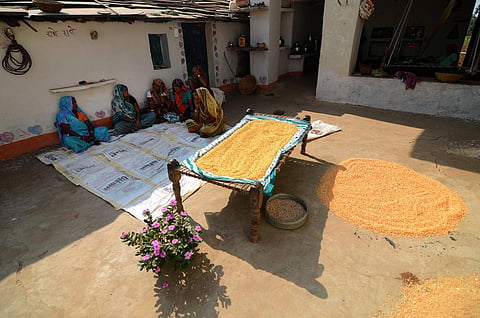

Seated on the last row of the ATR aircraft on a flight from Lucknow to Indore, I overheard a fellow passenger holding forth on the gastronomical delights of his city to the young cabin crew standing in the aft of the plane. The food scene in Indore comes alive at night, he was saying. So, if they ever had a "layover" in the city, he would be happy to take them around on a culinary tour. The conversation predictably led to Sarafa Bazaar - the jewellery market in Rajwada that transforms into a food street after the shops close. Having been there and done that (I mean the food haunts) I wasn't impressed. Nor were the ladies, I thought. The idea of having "Bhutta Ka Kees" (no pun intended, it is a Malwa speciality of mashed sweet-corn) in narrow alleys was not quite their idea of nightlife as I could make out from their reaction.
I have always been intrigued by the concept of bullion markets converting into food marts at night. Ahmedabad's Manak Chowk is another example. As per folklore, jewellers encouraged street vendors to open food stalls outside their shops after nightfall to keep burglars at bay. The outlandish innovations of Manak Chowk -- such as the Ice-Cream Sandwich -- may do just that.
In comparison, the fare at Indore's Sarafa Bazaar is far sober. Garadu (fried steamed yam), Shikanji (not what North Indians have but made of reduced milk and butter-milk with spices like saffron, cardamom, mace, nutmeg, dry fruits and nuts such as pista and almonds), Jaleba (large-size jalebis), Khopra Patties (Deep Fried Potato Balls stuffed with grated coconut). But they all leave me underwhelmed –- not because its all vegetarian but for their lack of distinct character.
Instead, give me Sabudana Khichdi from Apna Sweets any day. Spicy, spiked with hot tapioca chips, it has got the zing. But nothing excites an Indori as much as Poha. What sets Indore Poha apart from any other place is the special Jeerawan powder, which is supposed to be a mixture of eighteen spices -- with Amchur as the key differentiator.
The other food destination in Indore is "Chappan Dukan" the array of fifty-six shops, often referred to as just "Chappan". It is more up-market than Sarafa Bazar and resembles a modern food court. It offers a more contemporary choice with non-vegetarian options like its own version of hot dog, which is nothing like the American or European variety, but closer to a desi-burger served with coriander chutney and ketchup. However, it isn't as if Indore does not have good non-vegetarian food options. Some of the finest Shammi-Kebabs and Gurda-Kaleji I have had anywhere are from Nafees.
However, for the finest Nawabi Food one has to visit Jehan Numa Palace in Bhopal. I do not know of another restaurant in India that makes Peshawari Chapli Kebab like them. Though my personal favourite is the chicken korma they make with tender desi spring chicken. It is also a rare hotel that serves authentic Hyderabadi Haleem for breakfast on odd days. Filfora is another Kebab outlet in town. The more adventurous must venture to Chatori Gali in the old city at night for Muslim Street Food like one gets in the Jama Masjid area in old Delhi, Chowk - Aminabad in Lucknow or near Charminar in Hyderabad.
But why are we discussing city food in a predominantly tribal state like Madhya Pradesh?
Unfortunately, Tribal Food has not been marketed in India barring a few exceptions. Lately, food from North East states like Meghalaya and Nagaland are coming to be known thanks to a few ethnic restaurants opening in Delhi and some other cities. Still very little is known about the tribal food culture of other states.
ALSO READ | The joy of getting into a pickle in India
The home of the famous Kadaknath - one of the three breeds of Black Chicken in the world, the other two being from China and Indonesia - is the jungles of Jhabua and Alirajpur bordering Gujarat. Traditionally it was bred by tribals of the area. I first had Kadaknath at the farm of friends Rahul Banerjee and Subhadra Khaperde who work with Tribals in Dhar. To balance the spices, perhaps, Subhadra served delicious dried okra cooked in buttermilk along with millet bread. It is a pity that due to their poverty, tribals are having to turn to a vegetarian diet and even give up millet for cheaper grains like wheat. As tribals discontinue poultry farming, commercial breeding of Kadaknath has started and is being sold through supermarkets and online groceries at a premium for its supposed thereupatic properties, though it can never beat the free-range variety.
On the Eastern end of Madhya Pradesh is Baghelkhand around Rewa. Surrounded by forests, the region also has large expanses of arable land blessed by two rivers Son and Ton. It has its own distinct food with its own mix of cereals, vegetables and meat. They use a great deal of whole pounded whole spices. Bagheli Mutton is cooked with Khada Masala and country chicken with loads of ginger and whole spices. They eat a unique curry made of fermented cakes made of five kinds of lentils called Indrahar, which is supposed to provide extraordinary nutrition as the name suggests. Again millet is a staple in the region. They also make an interesting chutney of wild cherry tomatoes, garlic and chillies much like Thechha of Maharashtra.
ALSO READ | In search of India's finest Biryani
These hyper-local food traditions have to be revived and introduced to the rest of India. It can happen if Indoris get over their obsession with a hundred varieties of sev and divert their passion for Poha to make "Tribal Foods Great Again."
(Sandip Ghose is a current affairs commentator.)